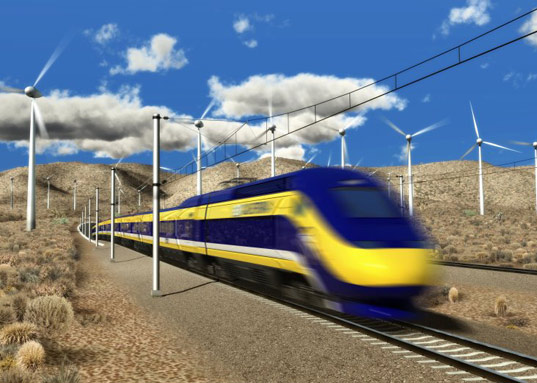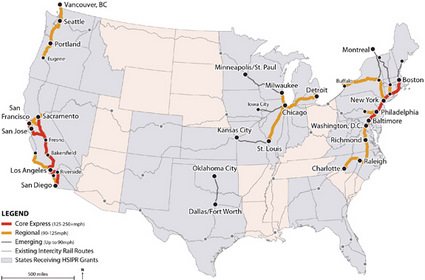It should have been a moment of celebration; the recent vote by California lawmakers to back the first phase of a high speed rail line in the state.
The legislative vote, which was passed thanks to the support of Democrat senators and just signed into law by the state’s governor, will free up $8 billion for the first stage of an ambitious project that envisages trains traveling at 220 MPH on a route linking the San Francisco Bay Area with Los Angeles and San Diego, while passing through inland cities like Fresno. But the celebrations will be on hold for now.

Even in the office of California Governor Jerry Brown, who risked much political capital on the plan, the time for cracking open the champagne is still some way off.
Brown still has to convince detractors, and a California electorate feeling the impact of long-term recession, that the rail plan is a viable investment and not simply a costly white elephant.
Rob Wilcox, a spokesman for the California High Speed Rail Authority (CHSRA), told EarthTechling that the $8 billion figure comprises $4.7 billion from state bonds (raised after California voters approved creating $10 billion in bonds for the project in 2008) and a further $3.3 billion of federal money granted to the state by the American Recovery and Reinvestment Act.
Wilcox said that majority of the funding freed up by the senate vote – some $6 billion — will go towards the project’s first phase, construction on the system’s opening segment in the Central Valley. The remaining money will go towards improvements to the current rail network that will allow it to be integrated with the high-speed link when it comes on line. Those improvements include $600 million for the electrification of the Caltrain corridor in the San Francisco Bay Area.
But the recent injection of cash doesn’t make the realization of the railway a fait accompli. Although the numbers sound big, they need to get a lot bigger. The entire bill for the 800 miles of track linking California’s two most populace cities is estimated at about $68 billion.
With the financial burden of this set to be borne by the California taxpayer, critics of the plan say now is not the time. Recent media reports have stressed the heavy toll the economic downturn has had on ordinary Californians.
Joe Simitian, the Democrat Senator for Palo Alto, one of the only Democrats to vote against funding the rail network, said it was wrong that Californians should be asked to fund this massive public work at a time when the state is struggling with budget woes that have forced it to cut services.
Speaking in a state senate debate ahead of the vote Simitian, who initially backed the rail plan, said: “Any of us who talks to our folks knows that they’re asking the same questions. They’re saying, ‘Really? You made these cuts. We’re threatened with more. And you want to build a high-speed train?'”
With the exception of Simitian, opinion about the rail plan was split down predictable party lines — all the Republican lawmakers voted ‘no.’ This reflects the ideological differences that continue to divide the two main parties: Fiscally conservative Republicans advocating that the country tighten its purse strings set against Democrats who see government investment in public works as a way to grow the economy out of recession.
Governor Brown, firmly in the last camp, called the senate vote “bold” and said work on the railway would help “get Californians back to work.” Other Democrats who supported the railway expressed the idea that they were investing in the state’s future and that this was too big a chance to let slip.
But even if its backers find the all funding, the raliway still faces a number of legal hurdles. The act just voted in requires a detailed funding plan, an accountability plan and environmental clearances for the entire project.
This last point could prove tricky since there are currently a dozen lawsuits pending, brought by agencies throughout the Central Valley against the CHSRA, which claim the railway will violate state environment laws.
It’s true, however, that all the controversy, especially the hand-wringing over cost, has distracted attention from the enormous gains the project will bring.
If all goes well, by 2033 California will boast North America’s first ever true high-speed rail network, capable of delivering commuters from L.A. to San Francisco in less than four hours.
Backers of the rail link say that by getting more cars off the roads it will reduce environmental damage, cut congestion and lower the state’s dependence on foreign oil.
They also say the initial outlay of building the railway will be paid back many times by the economic boost it will deliver in the long run by improving communications in the state.
UC Merced lecturer Dipu Gupta, an architect and urban designer, told the Los Angeles Times high-speed rail benefits all facets of an economy, an effect he referred to as its ability to “lift all boats.”

Not all academics agree with Gupta, however, and recent research, which looked at the impact of Japan’s bullet trains on the cities they passed through since the 1960s, claimed high speed rail did not necessarily equate to more jobs and a better economy.
Jerry Nickelsburg, a senior economist with the UCLA Anderson Forecast who authored the study, wrote that the railway “will have only a marginal impact at best” on California’s growth rates.
This analysis seems to be supported by the experiences of another major public works project that also suffered many setbacks in its construction and was frequently labelled a white elephant.
The Channel Tunnel rail link between Britain and France was completed in 1996, coming in 80 percent over-budget. Even to this day Eurotunnel, the private company set up to run the undersea rail link, is beset by debts that resulted in a coup by shareholders three years ago that led to the sacking of the entire board.
Meanwhile, studies of the regions that border the rail link, which connects London and Paris via a 30-mile long tunnel under the English Channel, show that its construction has made little difference to their economic prosperity.
But to focus too much on costs would be to miss a wider point. A marvel of design and construction (the tunnel has been classified as one of the Seven Wonders of the Modern World by the American Society of Civil Engineers), the Channel Tunnel has made it possible for commuters to go from central London to the bright lights of Paris in just three hours. Around 17 million passengers now take advantage of this journey each year.
It is impossible to really quantify all the gains in tourism and trade the rail link has ushered in by opening up Britain to continental Europe. Nor will it necessarily be possible to measure the net effect of California’s new wonder of engineering.
But while there surely will be massive gains for the state, only time will show exactly what those are.
State Senate President Darrel Steinberg (D-Sacramento) summed up this future potential when he urged lawmakers to support the project because, “How many chances do we have to vote for something this important and long-lasting?”